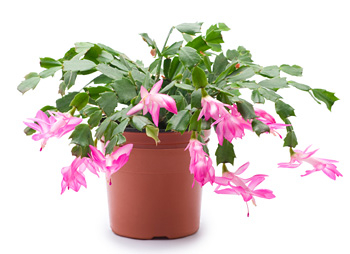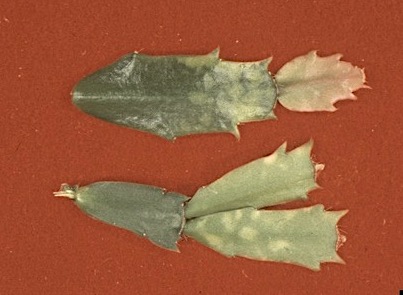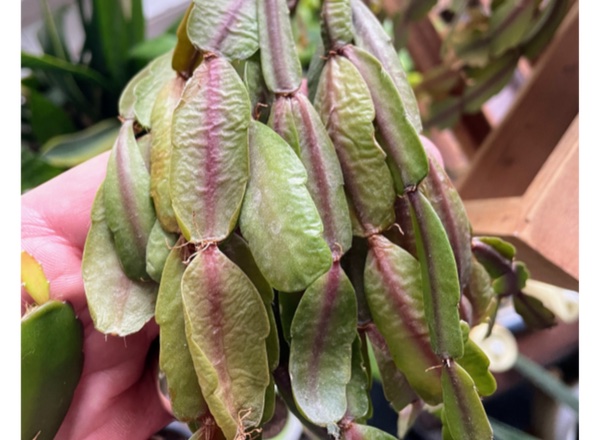Protect Your Holiday Blooming Cactus from Common Diseases
by Ray Novitske, Fairfax Master Gardener
 The holidays are made more colorful with a blooming holiday cactus. These succulents come in a variety of different colors and flower types, but their environmental requirements are all similar. They love bright indirect sunlight, moist soil but not too much water and our normal warm indoor temperature. There are some problem diseases that attack these beauties, but the good news is that most are preventable.
The holidays are made more colorful with a blooming holiday cactus. These succulents come in a variety of different colors and flower types, but their environmental requirements are all similar. They love bright indirect sunlight, moist soil but not too much water and our normal warm indoor temperature. There are some problem diseases that attack these beauties, but the good news is that most are preventable.
Necrotic Spot Virus
This is a plant virus that is mostly transmitted by thrips sucking on the plant tissue. The thrips can carry the virus, passing it along to the plants they infect just as some mosquitoes carry and spread some human viral diseases. The virus can also be spread by using infected tools, containers and soil.

Spot Virus
Signs of infection can be visual such as dead spots on leaves. But yellow leaves and wilting leaves and stems are more common, despite the presence of adequate water.
As with most plant viruses, there is little that can be done to cure the virus. Cut out infected areas of the plant and try repotting in clean soil to encourage the remaining plant to grow. If it is not infected, it may survive. Otherwise, it is recommended to discard the plant.
Botrytis Blight
As with many botrytis blights in outdoor plants, this is a fungus. The fungus feeds on the excess moisture in the soil and on infected decaying foliage. It is caused by high humidity together with excess water. Stems may appear gray or have a fuzzy coating.
To prevent this blight, keep water off the leaves when watering. Be sure there is adequate air circulation around the plant. To eliminate the blight, remove the infected leaves and stems — the entire plant is rarely infected. Leave the remaining plant to survive and ensure that watering and humidity needs are correct to prevent a return. Sometimes spraying with a copper-based fungicide as a last resort will work on a severely infected plant.
Stem Rot
This is sometimes called basal stem rot because it usually attacks the base of stems near the soil line. This is produced by two different fungi. As stem rot progresses up the plant, the infected tissue turns a lighter color or a tan color. Sometimes yellowish leaves appear. To prevent the fungus, do not overwater. Hold off watering until the soil has completely dried out.
As with the blight, damaged tissue or stems can be cut away in hopes that the remaining plant is uninfected and can survive. One can also take cuttings to propagate new plants from remaining uninfected leaves. Otherwise, it is wise to discard the plant.

Wilting wrinkled leaves
Root Rot
There are two types of root rot — phytophthora and pythium. These are not fungi but water molds. As the name implies, the damage is below the soil line in the roots where its presence cannot often be seen. Symptoms can appear on the visible parts of the plant such as wilted or stunted growth. If the plant is lifted from the soil, the infect roots can appear black or rotted.
To prevent the disease, just be sure the soil is never soggy. Do not water the plant when the soil is wet, and be sure to use a container with drainage holes at the bottom.
An attempt can be made to revitalize the plant but trimming away the rotted roots and repotting in fresh soil and in a new container. Otherwise, the plant should be discarded.
Preventing these diseases is easy. Be sure to take care of your holiday cactus plants by watering and maintaining proper moisture. You will be rewarded with many years of beauty if you do.
-
References
- Christmas Cactus – Stem and Root Rots, Pacific Northwest Extension
- Christmas Cactus Diseases, Penn State Extension
- How to Identify and Care For Holiday Cacti and Get Them to Rebloom, Illinois Extension